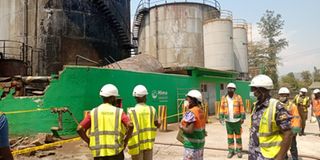Practical solutions to fire outbreaks

The team from National Building Review Board during their inspection of the Hima Cement factory on Sunday. PHOTO | MORIS MUMBERE
What you need to know:
- These incidents demonstrate that risk of fire constantly lurks over us both at our homes and our workplaces. Therefore, it is essential to identify all foreseeable fire risks and accordingly plan for them.
- It is also true that completely eliminating the risk of fire is an impossible endeavour, but it is feasible to reduce it to an acceptable level. In Uganda, the Building Control Regulations, 2020 define the acceptable fire risk by providing the minimum acceptable standards.
In the past few weeks, the media has been awash with stories of fire outbreaks. The most notable incidents have been a dormitory block at King’s College Budo in Wakiso, an apartment building in Masaka City in which two lives were lost, Megha Industries Ltd Factory Premises in Kyambogo the Kawempe school fire and Joint Medical Store Warehouse in Industrial Area, Kampala in which property estimated to be worth billions of shillings was destroyed.
These incidents demonstrate that risk of fire constantly lurks over us both at our homes and our workplaces. Therefore, it is essential to identify all foreseeable fire risks and accordingly plan for them. It is also true that completely eliminating the risk of fire is an impossible endeavour, but it is feasible to reduce it to an acceptable level. In Uganda, the Building Control Regulations, 2020 define the acceptable fire risk by providing the minimum acceptable standards.
However, more can be done to enhance fire safety at home and the workplace. So, the major question that needs to be answered is: What can you do as the building owner or occupier to ensure safety at your home or workplace?
Now, many fires have been started in buildings unintentionally mainly due to the occupant’s behaviour such as, smoking with no regard of where the ash is deposited; bad kitchen habits, unattended cooking; knowing what to do should a flash fire occur in a frying pan, i.e. smother the fire by carefully covering it rather than applying water to it.
Some fires have also been caused by electrical faults; Examples of habits that can lead to this include, leaving TVs and other electronic gadgets switched on for all day and all night, sometimes even without any audience; operating electrical appliances without following the manufacturer’s instructions, etc.
As the Ministry of Energy and Mineral Development works hard to increase access to electricity, alternatives to the use of open flamed candles should be seriously considered. Of late, gas cooking has become viable especially in urban areas, however, while it is regarded as a cleaner source of energy, this also comes with a significant explosion or fire risk.
To safely use gas, it must be ensured that there is absolutely no leakage, and if detected, no flame should be ignited, and neither should one even switch on a light until the house is properly vented and the leakage has been stopped. Good housekeeping also plays a crucial role in fire safety, for instance, combustible materials should be stored separately from possible ignition sources, and flammable liquids such as paint should be kept in appropriate containers.
Another common cause of fire outbreaks is arson, hence focus should also be put on good security arrangements to avert the risk of arson. However, these security arrangements should not hinder the escape of the building occupants to safety during an evacuation.
This is because typically, arsonists simultaneously start fires in several places to block escape routes.
That said, to ensure enhanced fire safety, buildings must be planned, designed and constructed to in accordance with Part V (Fire Safety) of our National Building (Building Standards) Code, 2019. Typically, the standards provide for means of escape in case of a fire outbreak, automatic fire detection, and alarm, and means of preventing internal and external fire spread, appropriate firefighting systems such as fire extinguishers, hose reels, automatic sprinkler systems, gas suppression systems, hydrants systems, wet/ dry risers, building compartmentation, etc.
Unfortunately, it is also common for people to disable the fire alarms when they get irritated instead of fixing the problem that triggered the alarm. There are also situations where cleaners for instance decide to use fire hose reels to do their tasks and when the time to fight the fire comes, the water in the tank has been depleted. It is important for owners and occupiers of buildings to ensure that the fire safety equipment is, not tampered with, regularly inspected and tested.
Whilst planning for buildings, it should be ensured that they are accessible to the Fire Prevention and Rescue Services of the Police, and that there are facilities for them use such as hydrant points. Finally, to effectively prepare building occupants to safely evacuate in case of a fire outbreak, regular fire drills and sensitisation are essential. Fire safety is everyone’s responsibility!
Eng Irene Priscilla Kobusinge is a Senior Investigations Officer, National Building Review Board.




